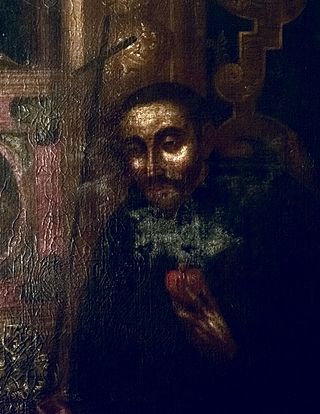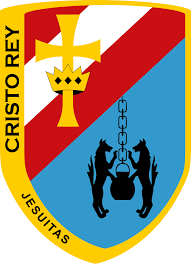Related Research Articles

Antonio Caballero y Góngora was a Spanish Roman Catholic prelate in the colonial Viceroyalty of New Granada, and from 1782 to 1789 the viceroy of New Granada.

The Real Audiencia of Quito was an administrative unit in the Spanish Empire which had political, military, and religious jurisdiction over territories that today include Ecuador, parts of northern Peru, parts of southern Colombia and parts of northern Brazil. It was created by Royal Decree on 29 August 1563 by Philip II of Spain in the city of Guadalajara. It ended in 1822 with the incorporation of the area into the Republic of Gran Colombia.
Joseph Cassani was a Spanish Catholic historian.

The Roman Catholic Archdiocese of Cartagena is an archdiocese located in the city of Cartagena in Colombia.

Antonio Ruiz de Montoya was a Jesuit priest and missionary in the Paraguayan Reductions.
Pablo Maroni was a Jesuit missionary to the Viceroyalty of Peru.
Ludovico Bertonio was an Italian Jesuit missionary to South America.
Pablo José Arriaga, SJ was a Spanish Jesuit missionary in South America.
Jacinto Barrasa was a Peruvian Jesuit preacher and historian.

The Jesuit Missions of Chiquitos are located in Santa Cruz department in eastern Bolivia. Six of these former missions collectively were designated as a UNESCO World Heritage Site in 1990. Distinguished by a unique fusion of European and Amerindian cultural influences, the missions were founded as reductions or reducciones de indios by Jesuits in the 17th and 18th centuries to convert local tribes to Christianity.

The Basilica and Convent of Saint Peter, formerly known as Basilica of Saint Paul after the school of the same name, is a Catholic church located in the historic centre of Lima, Peru.

Andean Baroque is an artistic movement that appeared in colonial Peru between 1680 and 1780. It is located geographically between Arequipa and Lake Titicaca in what is now Peru, where rules over the highlands and spreads over the entire altiplano. From the Portuguese word barrueco meaning impure, mottled, flamboyant, daring, the most striking example of Andean Baroque art is in religious architecture, where criollo and indigenous craftsmen together gave it a unique character, as happened in the New Spanish Baroque.

The Iglesia de la Compañía de Jesús is a historic Jesuit church in Cusco, the ancient capital of the Inca Empire, in Cusco Region, Peru. It is situated in the Plaza de Armas de Cusco, the city center. It is built on an Inca palace. It is one of the best examples of Spanish Baroque architecture in Peru. The architecture of this building exerted a great influence on the development of many Baroque architecture in the South Andes. Its construction began in 1576, but it was badly damaged in an earthquake in 1650. The rebuilt church was completed in 1673.

Aurelio Espinosa Pólit was an Ecuadorian writer, poet, literary critic, and university professor. He co-founded the Pontifical Catholic University of Ecuador, and he founded the Aurelio Espinosa Polit Museum and Library in Quito.
The Colegio Máximo de San José is a Jesuit religious college in San Miguel, Buenos Aires, Argentina. Pope Francis studied there during his youth.
Diego de Avendaño, was a Peruvian Jesuit, a theologian, jurist and moral philosopher. He was the author of the monumental Thesaurus Indicus, a study of the legal and moral issues typical of life in the Spanish-American colonies.

Bartolomé Lobo Guerrero was a Roman Catholic prelate who served as Archbishop of Lima (1607–1622) and the second Archbishop of Santafé en Nueva Granada (1596–1607).

Cristo Rey College, Tacna, is a private Catholic primary and secondary school, located in the city of Tacna in the south of Peru. The school was founded by the Society of Jesus in 1962.

Juan de Castillo was a Jesuit priest and missionary, and a martyr-saint of the Catholic Church. A Spaniard, he was one of the first to labor at the Jesuit reductions in Paraguay.

The Governorate of Maynas, also known as the Province of Maynas, was one of the provinces established at the eastern part of the Real Audiencia of Quito during the 17th century, first as part of the Viceroyalty of Peru and later as part of the Viceroyalty of New Granada until its reincorporation to Peru through the real cédula of July 15, 1802, as the General Command of Maynas.
References
- 1 2
 One or more of the preceding sentences incorporates text from a publication now in the public domain : Bandelier, Adolph Francis Alphonse (1907). "Diego Francisco Altamirano". In Herbermann, Charles (ed.). Catholic Encyclopedia . Vol. 1. New York: Robert Appleton Company.
One or more of the preceding sentences incorporates text from a publication now in the public domain : Bandelier, Adolph Francis Alphonse (1907). "Diego Francisco Altamirano". In Herbermann, Charles (ed.). Catholic Encyclopedia . Vol. 1. New York: Robert Appleton Company. - ↑ Pacheco, Juan Manuel. Los jesuitas en Colombia t. II (1962 ed.). p. 207.
- ↑ Pacheco, Juan Manuel. Los jesuitas en Colombia t. II (1962 ed.). p. 207.
- ↑ Pacheco, Juan Manuel. Los jesuitas en Colombia t. II (1962 ed.). p. 209.